Book contents
- Frontmatter
- Contents
- Abbreviations
- Maps
- Acknowledgments
- Introduction
- Chapter 1 This terrible custom
- Chapter 2 Church of the traitors
- Chapter 3 A poisonous brood of vipers
- Chapter 4 Archives of memory
- Chapter 5 The city of denial
- Chapter 6 Ravens feeding on death
- Chapter 7 Little foxes, evil women
- Chapter 8 Guardians of the people
- Chapter 9 In the house of discipline
- Chapter 10 Sing a new song
- Chapter 11 Kings of this world
- Chapter 12 We choose to stand
- Chapter 13 Athletes of death
- Chapter 14 Bad boys
- Chapter 15 Men of blood
- Chapter 16 Divine winds
- Chapter 17 So what?
- Appendix A Bishops and bishoprics in Africa: the numbers
- Appendix B Origins of the division: chronology
- Appendix C The Catholic conference of 348
- Appendix D The Edict of Unity and the Persecution of 347
- Appendix E The mission of Paul and Macarius
- Appendix F Historical fictions: interpreting the circumcellions
- Appendix G The archaeology of suicide
- Appendix H African sermons
- Bibliography
- Index
Chapter 3 - A poisonous brood of vipers
Published online by Cambridge University Press: 07 September 2011
- Frontmatter
- Contents
- Abbreviations
- Maps
- Acknowledgments
- Introduction
- Chapter 1 This terrible custom
- Chapter 2 Church of the traitors
- Chapter 3 A poisonous brood of vipers
- Chapter 4 Archives of memory
- Chapter 5 The city of denial
- Chapter 6 Ravens feeding on death
- Chapter 7 Little foxes, evil women
- Chapter 8 Guardians of the people
- Chapter 9 In the house of discipline
- Chapter 10 Sing a new song
- Chapter 11 Kings of this world
- Chapter 12 We choose to stand
- Chapter 13 Athletes of death
- Chapter 14 Bad boys
- Chapter 15 Men of blood
- Chapter 16 Divine winds
- Chapter 17 So what?
- Appendix A Bishops and bishoprics in Africa: the numbers
- Appendix B Origins of the division: chronology
- Appendix C The Catholic conference of 348
- Appendix D The Edict of Unity and the Persecution of 347
- Appendix E The mission of Paul and Macarius
- Appendix F Historical fictions: interpreting the circumcellions
- Appendix G The archaeology of suicide
- Appendix H African sermons
- Bibliography
- Index
Summary
If the religious conflict in Africa had been ignited by betrayal in the reign of Diocletian, it developed in complex and unforeseen ways during the last decades of Constantine's reign and over the remainder of the fourth century. This erratic history was marked by fluctuations between spates of violence and long periods of relatively peaceful coexistence. The back-and-forth shifts were provoked mainly by the changing agenda of emperors, although to a considerable degree the attitudes of the imperial court were deeply implicated in the provocations of the religious parties themselves. In these shifts, the Catholics and the dissidents found themselves variously advantaged or disadvantaged. In the decades after the mid-360s, following the watershed of Julian's reign, the hostile churches settled into a prolonged trench warfare in which each side carefully guarded its own flocks and made few inroads into the membership of the other. Because the written sources covering the period are so sparse, it is possible that this conclusion is too starkly drawn. Through the 370s and the 380s, however, the distinct impression is that each community strengthened its base and that a general balance between the two sides had settled in.
Little is known about the leadership ranks of the Catholics in these years. On the side of the dissidents, there was long-term stability under Parmenian, the bishop of Carthage and Primate of Africa. He had succeeded the great Donatus in the leadership of the dissident church around the year 360, and he remained in this commanding position until the early 390s. The successive long reigns of Donatus and Parmenian provided the dissident church with an enviable firmness at the helm. But Parmenian's three-decade-long tenure as Primate of Africa also had a hidden danger, since episcopal succession always had the potential for dissension and dispute. If there were serious competitors who brought political baggage with them into the struggle for power, the problem was only exacerbated. More tension was likely where the diocese was larger, boasted greater prestige, and had more resources at its command. The contentious election of Augustine as bishop of the diocese of Hippo Regius in 395 is one such reasonably well-documented case. Hippo was an unusually large, wealthy, and important diocese. Augustine's much-disputed choice as co-bishop to the aging and unimpressive Valerius was met with hostility that was only gradually overcome by hard lobbying and persuasion. If such potential for conflict existed at Hippo, it was much greater at Carthage, the pre-eminent see of all Africa. Here the ultimate in the way of material resources and rewards of authority and prestige were at stake with the selection of each new bishop, for the successor was not only chosen from a competitive field of candidates and became bishop of Carthage, he also became Primate of all Africa.
- Type
- Chapter
- Information
- Sacred ViolenceAfrican Christians and Sectarian Hatred in the Age of Augustine, pp. 107 - 145Publisher: Cambridge University PressPrint publication year: 2011

